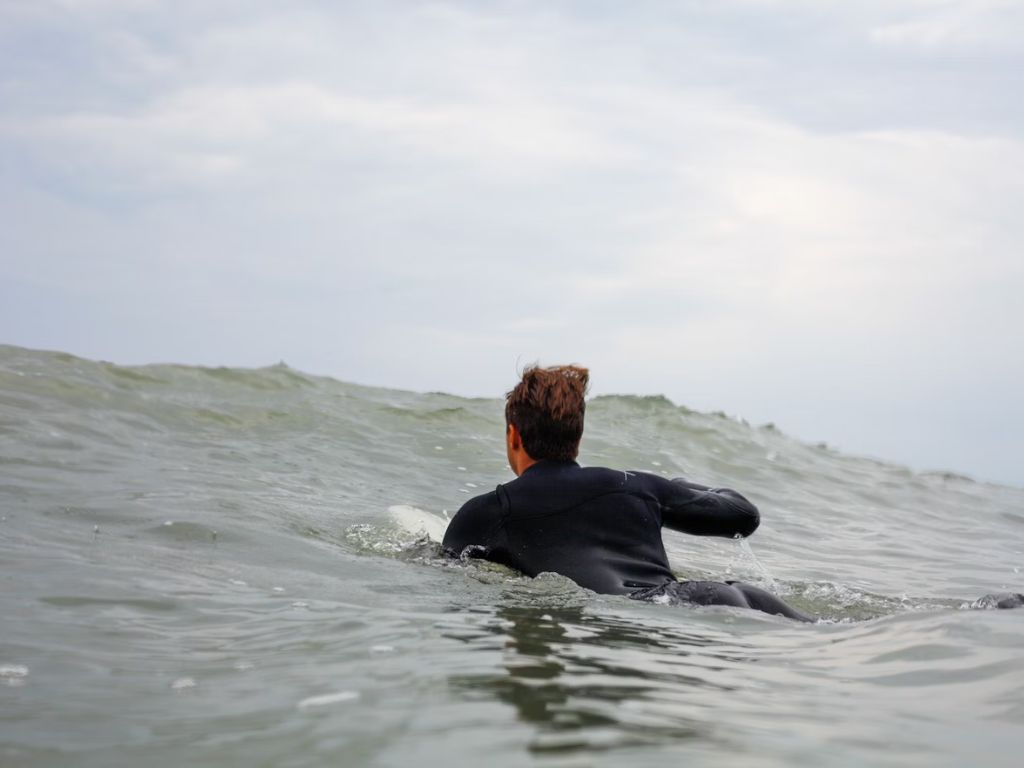Surfing is a thrilling sport that requires a lot of skills and practice. As a beginner, you may feel intimidated by the waves but don’t worry.
Slowly and steadily, you can begin to surf like a pro by practicing a few basic techniques. And two skills that every surfer should master are duck diving and turtle rolling. Both are crucial for getting past breaking waves and out to the lineup.
More importantly, these techniques can help you conserve energy and stay in the water for a long time. Before we dive into the details of these techniques, it’s important to note that mastering them requires practice and patience.
It’s normal to feel overwhelmed or frustrated initially but keep at it, and you’ll eventually get the hang of it. So, let’s get started and learn how to duck dive and turtle roll like a pro.
How to do duck diving while surfing?
Duck diving helps you get underneath an incoming wave while paddling out to the lineup. When performed correctly, it conserves energy and time.
1. Proper Steps
The technique for duck diving is relatively simple and involves the following steps:
Step 1: Paddle towards the incoming wave at an angle of about 45 degrees.
Step 2: As you approach the wave, place both hands on the surfboard rails and apply downward pressure, pushing the board under the water.
Step 3: As the board starts to submerge, arch your back, and push down on the board’s tail with your back foot.
Step 4: As the board disappears under the wave, push down with your hands to propel your body forward and through the wave.
Step 5: Once you emerge on the other side of the wave, resume your paddling position and continue towards the lineup.

2. Body Position
Maintain a low profile by bending your knees and keeping your head close to the board. Also, keeping your center of gravity low while diving is essential, as this helps prevent the wave from pushing you back.
3. Timing
Start the duck dive early enough to have enough time to get underneath the wave. However, if you start too early, you might save energy and miss the wave altogether. Similarly, if you start too late, the wave might catch you, resulting in a wipeout.
Common Mistakes to Avoid While Duck Diving
Although duck diving is a simple technique, it is common for beginners to make mistakes while executing it.
- Don’t lean too forward. You can lose your balance and wipe out. Keep your weight centered and your head close to the board.
- Apply consistent downward pressure. The board will not submerge completely without enough force..
- Pay attention to your timing. Starting too late can result in the wave catching you, causing a wipeout. You must start your dive early enough to push your board under the wave effect.
- Don’t be too slow. It can prevent you from missing the wave, wasting energy, or getting caught by the wave. To avoid this, be quick and assertive while diving.
- Use proper body position. You must be positioned to push your board under the wave. Keep your weight forward and put your back foot on the tail of your board.
- Commit religiously to this. If you hesitate or pull back at the last minute, you won’t be able to effectively push your board under the wave.
By avoiding these common mistakes, you can improve your duck diving technique and maximize your surfing experience. Remember, it takes practice to perfect this technique, so keep trying, and you’ll get there!
How to do turtle rolling?
Turtle rolling is another essential technique for surfers to master, particularly when the waves are too large to duck dive. Turtle rolling, also known as a turtle dive, involves flipping the surfboard over and holding onto the rails while the wave passes.
Here’s how to perform a turtle roll:
Step 1: Identify the right wave.
To successfully perform a turtle roll, you must identify the right wave. It’s crucial to note that you need to be in deep water before attempting this move.
Step 2: Position yourself correctly.
You should position yourself before the wave reaches you. Move towards the front of the surfboard, lie flat on your stomach, and hold onto the rails near the nose of the board.
Step 3: Flip the board.
As the wave approaches, pull the nose of your surfboard downwards and flip the board over so that it is upside down. Grab the rails tightly to keep the board close to your body.
Step 4: Hold your breath.
As the wave passes over you, hold your breath and let your body sink underwater. Hold onto the board and maintain a low profile.
Step 5: Come back up.
Once the wave has passed, return to the surface and quickly reposition yourself on the board.
By following these common guidelines and following the proper technique, surfers can effectively use turtle rolling to navigate through large waves.

Common Mistakes to Avoid While Turtle Rolling
Beginners can often find rolling a turtle a bit challenging, and they may need to correct some common mistakes that affect their ability to perform it successfully.
Here are some common mistakes beginners make while turtle rolling and tips on avoiding them:
1. Pay attention to your timing.
The key to timing the turtle roll correctly is to be aware of the approaching wave’s direction and speed. You need to start the turtle roll just before the wave breaks.
If you start too early, you won’t be able to push your board deep enough underwater. In contrast, if you start too late, the wave will push you back and throw you off your board.
2. Position the board correctly.
You must place your board perpendicular to the approaching wave to perform the turtle roll. This position helps you duck under the wave without getting hit.
However, some beginners position their board at an angle, making it difficult to roll it underwater. To avoid this mistake, ensure that your board is perpendicular to the wave and that you hold the rails tightly.
3. Need to arch your back more.
This position enables you to push your board deep enough underwater to avoid the impact of the wave. Although, some beginners need to arch their backs more, making it challenging to push their board underwater.
To avoid this mistake, focus on arching your back as much as possible when performing the turtle roll. Practicing this technique on land can also help you perfect your form.
4. Hold onto the board correctly.
Holding onto your board’s rails is crucial to maintain control while performing the technique. Some beginners must avoid holding onto the board’s center, making it challenging to control the board underwater.
5. Use the right amount of force.
Some beginners use too much force, which can cause them to lose control of their board. Others use too little force, pushing the board underwater.
Practice using the right force to push your board underwater to avoid this mistake. Remember to keep your back arched and tightly held onto your board’s rails.
When to use duck diving vs. turtle rolling
Knowing when to use the right move is crucial in surfing, as it can significantly impact your experience and safety in the water.
1. When to go for a duck dive?
Duck diving is most effective in small to medium-sized waves, where the wave is breaking close to you. This technique is particularly useful when the wave is too steep to paddle over or if multiple waves are approaching quickly.
The key to effective duck diving is timing. You should start paddling towards the wave while it is still a few feet away, with your head down, arms extended, and hands gripping the rails.
As the wave approaches, take a deep breath, press down on the tail of your board with your back foot, and lean forward, using your momentum to dive under the wave. Once underwater, use your hands to push down on the board and your back foot to lift the tail, allowing you to pass under the wave and resurface on the other side.
2. When to go for a turtle roll?
Turtle rolling is most effective in larger waves, where the wave is breaking further away from you. This technique is particularly useful when the wave is too powerful or steep to duck dive or when you cannot dive due to fatigue or injury.
The key to effective turtle rolling is to stay as close to your board as possible. When a wave approaches, turn your board around, placing it perpendicular to the oncoming wave, with your chest on top of it and your arms hugging the rails.
Take a deep breath and submerge your body under the water, holding onto the rails of your board. As the wave passes over you, use your body weight to keep the board as flat as possible, preventing it from flipping over. Once the wave has passed, resurface and resume paddling.
Tips and Tricks to Master New Surfing Techniques
While mastering the techniques of duck diving and turtle rolling may take some time, some tips and tricks can help improve your skills and make the process easier.
Here are some of the most useful tips for improving your duck diving and turtle rolling:
- Practice your paddling technique.
- Perfect your timing.
- Stay relaxed.
- Use your hips.
- Keep your head down.
- Practice on smaller waves first.
- Be patient.
By following these tips and tricks, you’ll be well on your way to mastering the techniques of duck diving and turtle rolling and improving your overall surfing skills.
Expert QnA
Q. Do I need to know how to duck dive and turtle roll to surf?
Knowing how to duck dive and turtle roll can be incredibly helpful for surfers, however, it’s not necessarily a requirement to know these techniques to surf.
Q. Are these techniques difficult to learn?
Learning how to duck dive and turtle roll can be challenging, especially for beginners, but with practice and persistence, anyone can master these techniques. It’s recommended to practice these techniques on smaller waves before attempting them on larger, more powerful ones.
Q. What if I can't hold my breath for very long?
If you cannot hold your breath for very long, it may be challenging to perform duck dives and turtle rolls. Although, with practice and building up your lung capacity, you can improve your ability to hold your breath for longer.
Q. Do I need any special equipment to perform these techniques?
Generally, you don’t need any special equipment to perform duck dive and turtle roll. That said, having a well-fitted wetsuit and surf leash can make it easier to perform these techniques and can also provide additional safety and comfort while surfing.
Q. Are there any risks associated with duck dive and turtle roll?
If not executed properly, you may end up being held down by the waves for too long, resulting in a lack of oxygen and panic. You must practice these techniques in a safe and controlled environment before trying them in more challenging conditions.
Additionally, it’s essential to know your limits and avoid attempting these techniques in waves that are too big or strong for your skill level.





